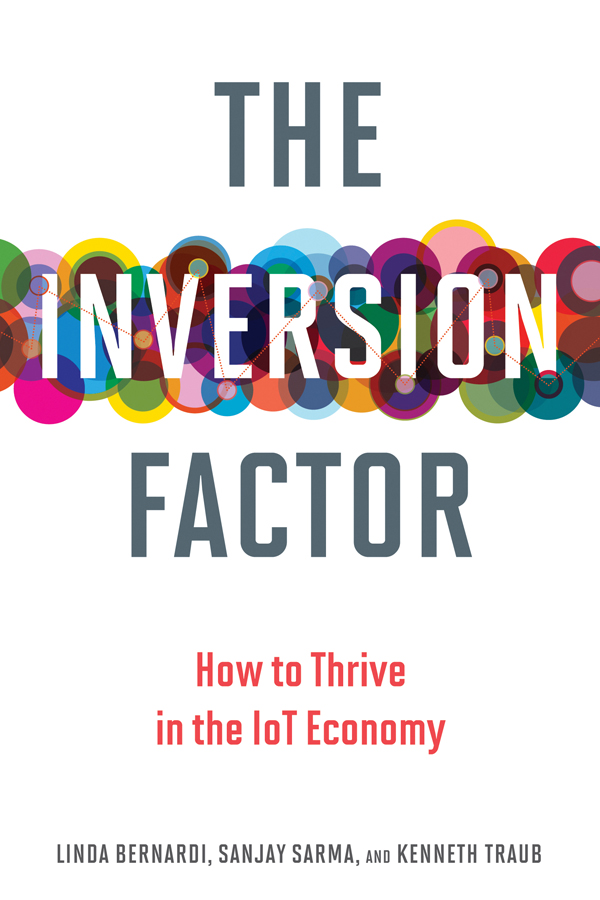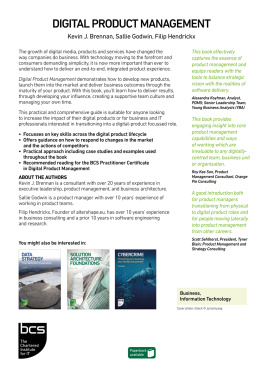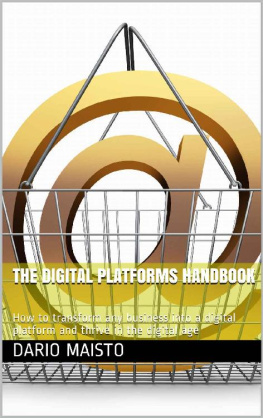Contents
Guide
Pagebreaks of the print version

THE INVERSION FACTOR
How to Thrive in the IoT Economy
Linda Bernardi, Sanjay Sarma, and Kenneth Traub
The MIT Press
Cambridge, Massachusetts
London, England
2017 Linda Bernardi, Sanjay Sarma, and Kenneth Traub
All rights reserved. No part of this book may be reproduced in any form by any electronic or mechanical means (including photocopying, recording, or information storage and retrieval) without permission in writing from the publisher.
This book was set in Stone Serif by Westchester Publishing Services.
Printed and bound in the United States of America.
Library of Congress Cataloging-in-Publication Data
Names: Bernardi, Linda, author. | Sarma, Sanjay E., 1948 author. | Traub, Kenneth R., author.
Title: The inversion factor : how to thrive in the IoT economy / Linda Bernardi, Sanjay Sarma, and Kenneth Traub.
Description: Cambridge, MA : MIT Press, [2017] | Includes bibliographical references and index.
Identifiers: LCCN 2017019904 | ISBN 9780262037273 (hardcover : alk. paper)
Subjects: LCSH: New products. | Internet of things. | Technological innovationsEconomic aspects. | Strategic planning.
Classification: LCC TS170 .B47 2017 | DDC 658.5/75dc23
LC record available at https://lccn.loc.gov/2017019904
For Ken Traub (19622017)
We shared our dream of writing The Inversion Factor with Ken, our beloved friend, collaborator, and coauthor. His untimely death, just as our manuscript neared completion, leaves us heartbroken but resolute in our determination to present our (and his) vision of the emerging hyperconnected world, and to enable our readers to participate in shaping that world.
Contents
Introduction
Things Arent What They Used to Be
History rarely comes with clean lines of demarcationobvious, self-contained inflection points where one era stops and another era clearly begins. Such moments do occur from time to time: one came to pass in Boston on March 10, 1876, when Alexander Graham Bell spoke into his electromagnetic gallows phone the famous words, Mr. Watson, come here, I want to see you, and his assistant, Thomas Watson, answered. Another such inflection point may have occurred with the founding of Zipcar in Cambridge, Massachusetts, in 2000.
The iPhone was seven years away. Facebook would not debut for four more years. Most Americans accessed the Internet through dial-up modems and Ethernet cables; Wi-Fi was a rarity. AOL and Time Warner were consummating what would become one of the most disastrous corporate mergers in U.S. corporate history. Amazon had yet to turn a profit. Microsoft dominated the tech world by selling office productivity suites and most hardware makers were trying to figure out how they could use the Internet to sell more boxes.
Meanwhile, Antje Danielson and Robin Chase had something else in mind. They knew that in the United States, the average car is parked about 95 percent of the time, translating to millions of potential transport miles sitting idle. Inspired by early Swiss and German car-sharing ventures, they wondered if, instead of developing another vehicle for moving people from point A to point B, they might reimagine how people interacted with vehicles.
The result was Zipcar. The company allowed users to choose from a selection of fuel-efficient cars parked in dedicated spaces around host cities and to reserve a block of drive time. Users would unlock their car with a radiofrequency identification (RFID) card (today, its a smartphone app) and only pay for the time they drove the vehicle. Zipcar, which Avis Budget Group acquired in 2013 for roughly $500 million, freed students and city dwellers from the need to own a car.
Zipcar also pioneered a range of technologies that foreshadowed the Internet of Things, or IoT: transponders that record time of use and mileage driven and wirelessly upload data to a central computer and a remote kill function that disabled the ignition system in case of theft. Zipcar was more than the first start-up in the auto space to use technology to turn shared resources into the sharing economy; in many ways, it was the first business to make IoT the cornerstone of its business model. Now, as connected, intelligent, even self-driving vehicles from players as diverse as Tesla and Google begin to move from concepts to reality, it is important to recognize that technology alone did not make Zipcar a pioneer. The x-factor was how they thought about the market they were trying to serve.
Rather than ask, What new technology can we build and sell to people to transport people? Danielson and Chase chose to ask, How can we reinvent how people get where they need to go, using technology? The first question begins the discussion with product, and in doing so, automatically limits the answers to variations on existing solutions. By beginning the discussion with the underlying customer need, the second question frees entrepreneurs and innovative engineers to unlock fresh solutions to old needs, identify previously hidden markets, create new wealth, and even transform the worlds economy.
Things Have Changed
For the history of commerce, things have simply been things. Today, we are seeing a transition from things to systems capable of two earth-shaking behaviors: computing and connecting to other things. When human beings first started using things as tools, function followed form: a rock is big and heavy, so it could be used to break things. A stick is long and pointy, so it could be used to stab things. As humans learned to adapt materials to their own ends, and the craft of manufacturing arose, humanity evolved to a state where form followed function. A designer conceived of some function he wanted a thing to do, devised an appropriate form that would fulfill that function, and then made the thing. If he wanted a thing that would drive small objects, he made a hammer. If she wanted a thing that would cut through stalks of wheat, she made a scythe.
The industrial age gave people an ever-widening palette of materials and construction techniques to use: metals, glass, plastics, ceramics, composites; forging, stamping, milling, welding, molding. Mass production also led to standardized components: screws, nails, beams, wheels, gears, wires, motors, batteries.
Microprocessor technology is the ultimate standardized component, one that can do anything. The development of the microprocessor put limitless power into the hands of the designer. While mechanical functions are limited by the nature of the materials and the laws of physics, in the digital realm, any function the designer can imagine can be realized by the microprocessor. The result: things that can do things that would be impracticalor impossibleby purely mechanical means. You want a microwave oven that lets you set the cooking time to the exact second and has presets for popcorn and pizza? Hard to do with a mechanical dialbut no problem with a microprocessor. Digital electronics led to the discipline of user interface engineering, as functions could be finely adapted to the needs of human users.
However, even with microprocessors, a thing is still a thing. It is self-contained and only operates within the confines of its physical shell. It carries out only those functions that its designer envisioned when it was fabricated. The fact that this thing contains a powerful computer inside is a boon to the designer, but it is






